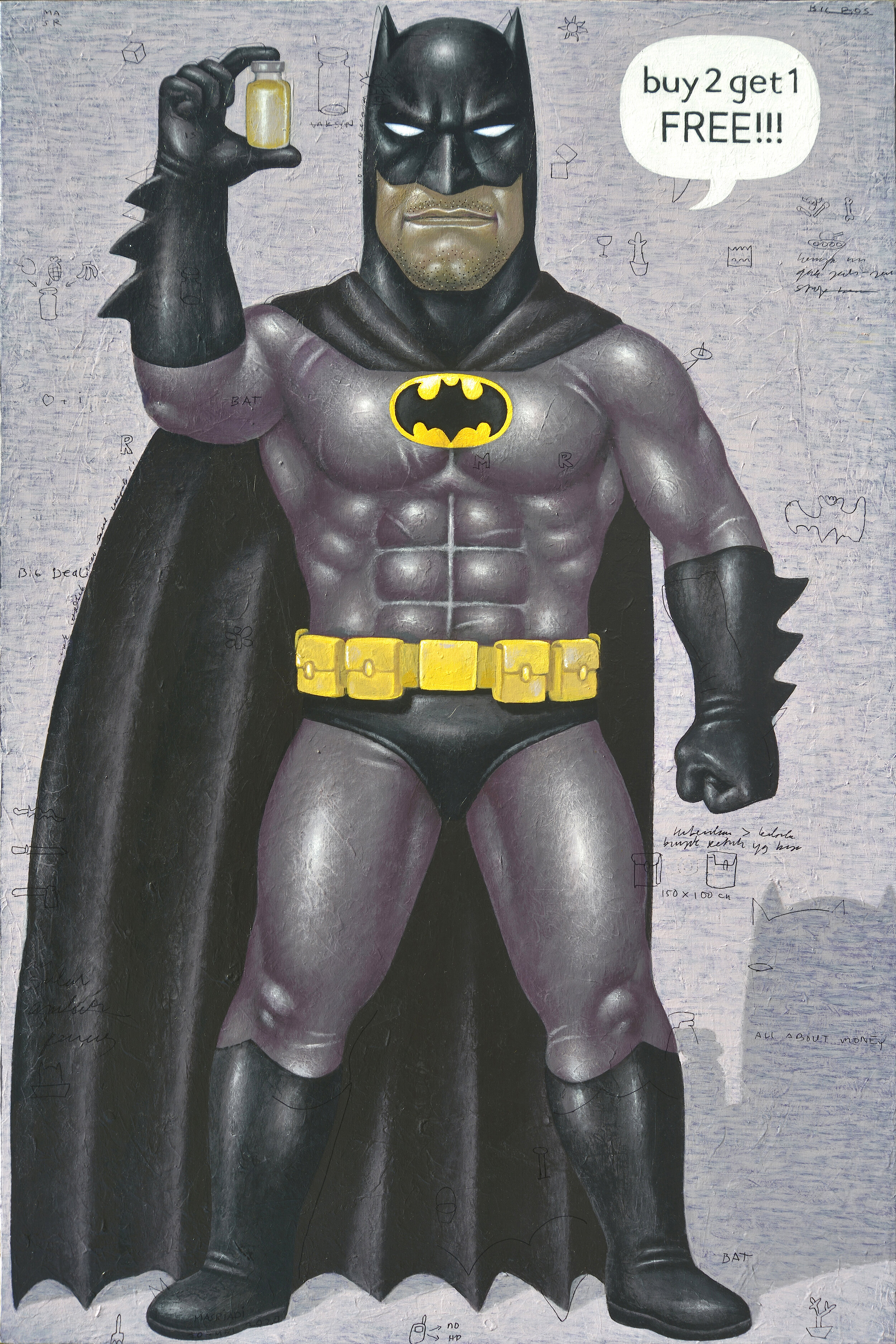Superheroes: the Anti-heroes of Art
The stacks of paperback form a line in the shelves; the scent of vintage and freshly printed ones wafts in the bookshop. A young I Nyoman Masriadi reaches for a book and rifles through its pages. Inside, colored illustrations make up the pages with bubbles on top or beside the characters, inanimately mouthing a string of words shorter than a paragraph. The actions are swift, the storytelling is snappy, and his thumbs moisten the paper from pressing on the pages as he reads. Captivated by the allure of the sketches and stories, Masriadi finds his muse in the den of comic books.
At a young age, the Indonesian artist, whose artworks today have regularly fetched high auction prices, making him one of the most successful Southeast Asian artists, would read comic books and watch commercial action movies that involve superheroes, the roots of his influences and references in art. After graduating from middle school, he enrolled at Sekolah Menengah Seni Rupa (The High School of Fine Arts), an alternative to the standard high school system with a focus on art and continued his studies at Institut Seni Indonesia Yogyakarta (Indonesian Art Institute of Yogyakarta), but returned home to Bali without graduating to hone his artistic skills on his own.
We are Metekol by Nyoman Masriadi
In ArtThou’s exclusive interview with the artist, he mentioned that he had worked as an art retailer on the street to sell his artworks. “At that time, I felt that being a student meant I had too much work or too many assignments to do, and I could not create the art I wanted. Back then, I also faced opposition at school drawn from my style of black figures in drawings.” Those protagonists have taken the center stage in Masriadi’s body of work; a maelstrom of black and brown characters built as bodybuilders wearing superhero costumes.
Masriadi divulges into the culture and history of Indonesia, offering clever and often biting social commentary on contemporary life and global pop culture. Backed by his refusal to conform to codes of society and standards in art, his artworks comprise powerfully built men and women engaged in solitary acts of strength or captured in private moments of vulnerability. “As an ordinary person who is part of the contemporary crowd, my words could act as a sample of the populace, but I would not shy away from criticizing or parodying the masses themselves.”
Batman's Promotion by Nyoman Masriadi
In our interview, Masriadi peeled the layers of stories behind his recent paintings, especially those he created at the height of the pandemic. “Taking suggestions from C Matahari, my six-year-old daughter, Save the World illustrates a well-known superhero figure giving people hope in times of uncertainty. While it paints how the world wants a superhero now, there is also a certain arrogance and savior complex coming from this character that comes off as a side effect of excessive reliance.” Such reliance of people towards authoritative figures has placed Superman on a podium against a backdrop of a blue sky and white clouds, while the crowd huddles up below his feet to worship his arrival and be blessed by his salvation: the powerful over the powerless.
The interwoven politics in the absurdity of a commoner’s mentality appears in his two other paintings. Parodying the social media posts on the global thirst for a cure, Batman’s Promotion portrays the savior of the pandemic as he holds a newly developed vaccine for the virus. “Here I highlight how the general population craves for an immediate solution; a superhero figure serves as their cure-all medicine. I imagine this absurdity in a humorous way — how Batman promotes the vaccine like any other salesman, and how through being the savior of the world, he has started to show an indication of arrogance.” His offer of buy two, get one free illustrates and tracks the business behind vaccine selling and production, underlining the thought of luring in the public to purchase more; the side effect of political advertising.
In the next painting, a homage to the phony body goals at home, We are Metekol, which can be translated as We are Buffed, depicts Masriadi’s fitness journey and diet routine during quarantine. The three muscular figures exaggerate the ideal body the artist wants to see at the end of his efforts, echoing the hundreds, if not millions, of people who post their first attempts to a green and healthy lifestyle on social media before quitting.
The fantasy of power sprawls across the canvases of Masriadi’s art to caricature the public, to toy with the unevolved perception of the masses, and to unveil the absurdity of collective thinking. He has devised comic-like illustrations to incite ruminations at a time of political and individual crisis. Cultivating cultured and awakened superheroes, the artistic storytelling of I Nyoman Masriadi drifts us back into our childlike spirit while emphasizing the folly in mankind's nature.
Words by Matthew Burgos


